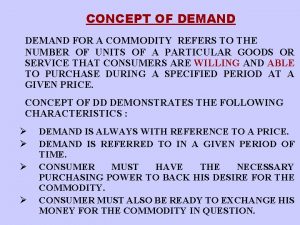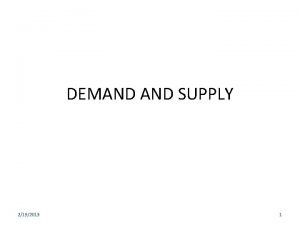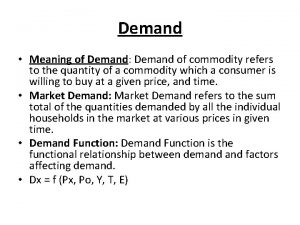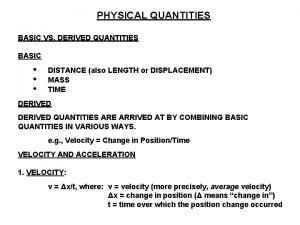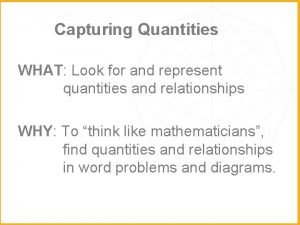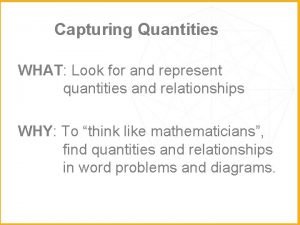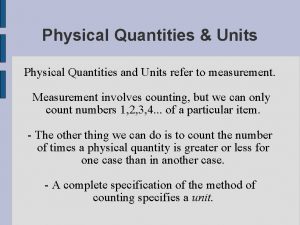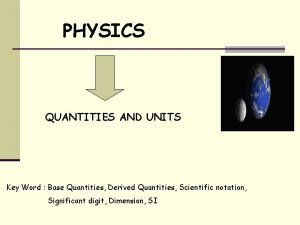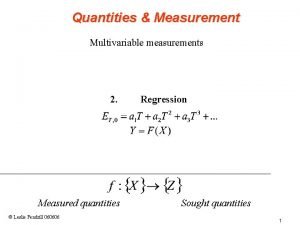DEFINITIONS OF DEMAND Demand refers to the quantities















- Slides: 15

� DEFINITIONS OF DEMAND � Demand refers to the quantities of a commodity that the consumers are able and willing to buy at each possible price during a given period of time, other things being constant. � Constituents of demand Ø Desire Ø Money to satisfy desire Ø Willingness to spend Ø Relationship of price and quantity demanded Ø Relationship of time and quantity of commodity demanded

� Law of demand holds good when ‘other things remain the same. ’ � All determinants of demand other than the price remain unchanged. Ø no change in the price of related goods. Ø No change in the income of the consumer Ø No change in taste and preferences

� There is an inverse relationship between price and demand for a commodity. It indicates the direction of change in demand as a result of change in price. � Ø Ø Ø DEMAND CURVE SLOPE DOWNWARD Law of diminishing marginal utility: a consumer demands a commodity because it has utility. As he consumes more and more units of a commodity, in a given time, the utility derived from each successive units goes on diminishing. Marginal utility of any good diminishes as more and more of that good is purchased. Marginal utility is the addition made to the total utility by consuming one more unit of a commodity.

Utility schedule units of commodity 1 2 3 4 marginal utility(measured in rupees) 8 6 4 2

Ø Ø Ø ALGEBRIC EXPLANATION Mu(1)/p(1) = Mu(2)/p(2) = ……. Mu(n)/p(n) INCOME EFFECT: it is the effect that change in person’s real income caused by change in the price of a commodity has on the quantity of that commodity. Fall in the price causes increase in the real income and so extension in demand. On the contrary, rise in price causes decrease in real income and so contraction in demand. SUBSTITUTION EFFECT: it is a effect that a change in relative prices of substitute goods has on the quantity demanded. Substitutes are goods that can be used in place of each other. For example tea and coffee. To get maximum satisfaction, a consumer will buy more units of that commodity whose price, in relation to its substitute, has gone down. The consumer substitutes cheaper good for the good whose price has not altered.

DIFFERENT USES Some goods have more than one use. Milk, may be used for drinking and for making curd and cheese. At its high price an individual consumer may buy milk for drinking only, but at the reduced price milk may be bought for making curd and cheese as well. Ø SIZE OF CONSUMER GROUP Ø When the price of a commodity falls, then many consumers, who are unable to buy the commodity at its previous price, come forward to buy it. As a result total demands go up. Ø

� Positive slope of the demand curve. price quantity Articles of distinction � Veblen goods are articles of distinction or luxury goods like jewelry, original works of art by great artists. � These goods command more demand when their prices are high. �

IGNORANCE Consumers out of ignorance or poor judgment consider a commodity to be of a low quality if its price is low and of high quality if its price is high. GIFFEN GOODS These are those inferior goods whose demands falls even when their price falls, so that the law of demand does not hold good EXCEPTION OF RISE OR FALL IN PRICE IN FUTURE If prices are likely to rise more in the future then even at the existing higher price people may demand more units in the present. If prices are likely to fall further in future then even at the existing lower price people may demand less in the present.

1. Price of the commodity Other determinants remaining constant, change in the price of a good causes an inverse change in its demand. Rise in prices causes contraction in demand fall in prices causes extension of demand. This relationship is called LAW OF DEMAND. 2. Price of related goods Related goods are classified as substitute goods and complementary goods. SUBSTITUTE GOODS: In case of substitute the quantity demanded of one good is positively related to the price of other good. If price of one good increases the demand for substitute increases. COMPLEMENTARY GOODS: These are those goods which complete the demand for each other. There is negative relationship between t e demand for first good and price of the second good

DIAGRAMMATIC REPRESENTATION Substitute goods � complementary goods Y y demand for p 1 demand for substitute complementary p p o q q 1 x o goods q q 1 x 3. INCOME OF THE CONSUMER There is a positive relation between income of the consumer and his demand for a good. The relationship between income of the consumer and demand for a commodity is discussed with reference to: normal goods, necessaries, inferior goods.

Relationship between income and demand for the commodity Normal goods • These are those goods the demand for which tends to increase with the increase in consumer’s income, and decrease with the decrease in income. • These are those goods the demand for which tends to decline following a rise in consumers Inferior income, demand increases with fall in income. goods • The demand remains constant irrespective of the level of income. For example salt and match necessar box. ies

TASTE AND PREFERENCES � It includes fashion, habit custom etc. tastes and preferences are influenced by advertisement, change in fashion, new inventions etc. other things being equal, demand for those goods increases in which consumer develop taste and preferences. EXPECTATIONS change in consumers expectations about such things as product prices, product availability and future income is another determinant of demand. DISTRIBUTION OF INCOME if there is uneven distribution of income, there will be more demand for luxury goods, on the other hand if income is evenly distributed, there will be less demand for luxury goods and more demand for necessaries and comforts.

INCREASE AND DECREASE IN DEMAND : SHIFT IN THE DEMAND CURVE INCREASE IN DEMAND � Rise in demand in response to change in determinants of demand other than the price of the product � Demand increases in two ways: same price more demand more price same demand. � It causes rightward shift in demand curve. � DECREASE IN DEMAND � Fall in demand in response to change in determinants of demand other than the price of product. � Demand decrease in two ways: same price less purchase and less price same purchase. � � It causes leftward shift in demand curve.

DISTINCTION BETWEEN EXTENSION IN DEMAND INCREASE IN DEMAND � Extension in demand � Rise in demand in response to fall in prices of a commodity, other things being equal. � It is expressed by a movement from a higher point to a lower point along the same demand curve. � Increase in demand � It refers to the rise in demand in response to change in the determinants of demand. � It is expressed by the upward shift of the entire demand curve.

Contraction of demand � Fall in the demand in response to a rise in the price of a commodity, other things being equal. � It is expressed by a movement from a lower point to a higher point along the same demand curve. � � Decrease in demand � Fall in demand in response to change in determinants of demand, other than the price. � It is expressed by the downward shift of the entire demand curve.
 Linear quantities
Linear quantities Demand for a commodity refers to a
Demand for a commodity refers to a Demand refers to
Demand refers to Một số thể thơ truyền thống
Một số thể thơ truyền thống Hệ hô hấp
Hệ hô hấp Công thức tính độ biến thiên đông lượng
Công thức tính độ biến thiên đông lượng Số nguyên tố là
Số nguyên tố là đặc điểm cơ thể của người tối cổ
đặc điểm cơ thể của người tối cổ Tỉ lệ cơ thể trẻ em
Tỉ lệ cơ thể trẻ em Các châu lục và đại dương trên thế giới
Các châu lục và đại dương trên thế giới ưu thế lai là gì
ưu thế lai là gì Môn thể thao bắt đầu bằng chữ f
Môn thể thao bắt đầu bằng chữ f Tư thế ngồi viết
Tư thế ngồi viết Thẻ vin
Thẻ vin Hình ảnh bộ gõ cơ thể búng tay
Hình ảnh bộ gõ cơ thể búng tay Cái miệng bé xinh thế chỉ nói điều hay thôi
Cái miệng bé xinh thế chỉ nói điều hay thôi

